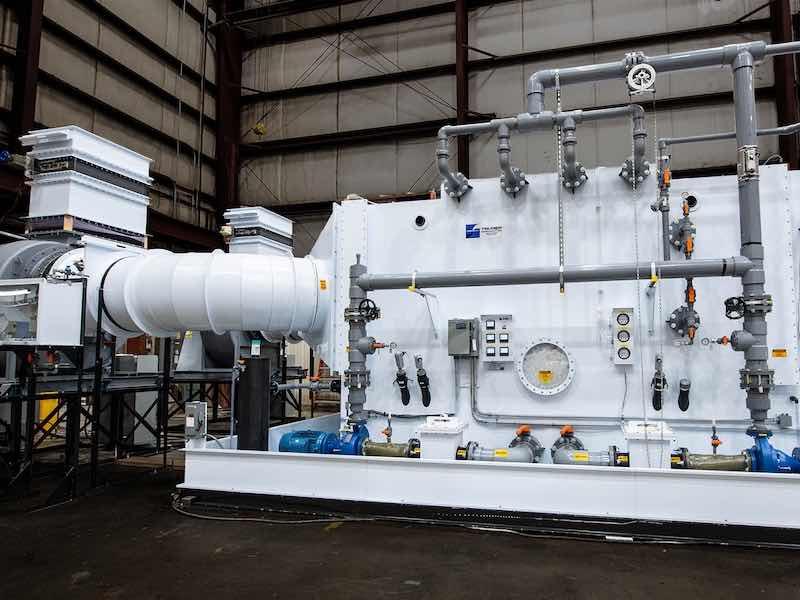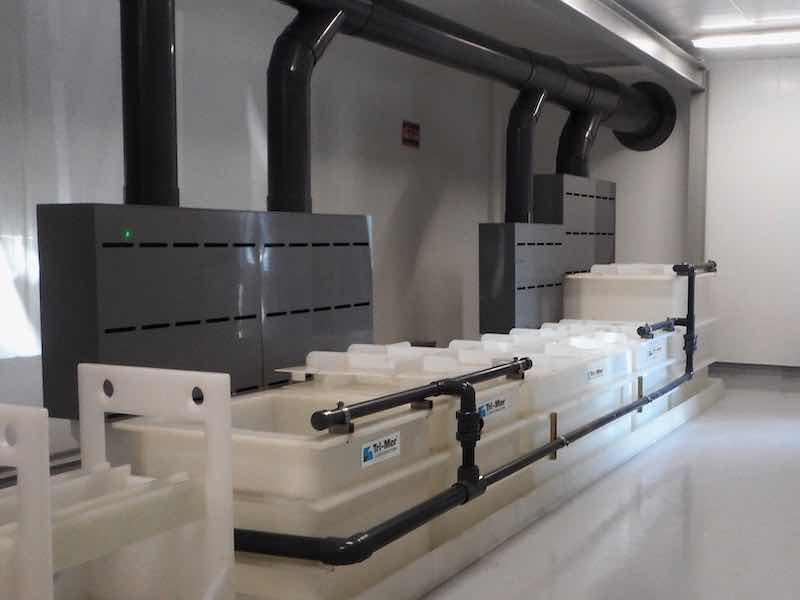We spoke with Asa Halliday of Tri-Mer about designing and operating an effective exhaust system for facilities with finishing lines, including scrubber maintenance.
 Asa HallidayHalliday discussed maintaining appropriate gas velocities throughout the system and the need for an effective source capture / local exhaust ventilation.
Asa HallidayHalliday discussed maintaining appropriate gas velocities throughout the system and the need for an effective source capture / local exhaust ventilation.
He also discussed how shops could use a mist eliminator in hoods to keep ductwork clean and about ductwork velocities to minimize material fallout.
“Emission controls are not something that necessarily make money or optimize processes, but certainly, it's something you need to take care of,” Halliday says. “And if it's done appropriately, it minimizes downtime, which can improve your process overall.”
Visit www.Tri-Mer.com
Tim Pennington: We're talking today about the design and operation of effective exhaust systems for facilities with finishing lines, including scrubber maintenance. It’s important for all finishing operations to have systems in place to stay compliant and keep utility costs in check.
Asa Halliday: Yes, of course, emission controls are not something that directly makes money or optimizes processes, but if done appropriately, it minimizes downtime and is better for the operation overall. One of the first things we look at is documentation on the original system in order to understand the design considerations. The goal is to determine whether and how the system currently deviates from its design parameters.
TP: I ran an article two weeks ago on air quality in finishing operations. The study indicated that finishing operations with quality air emissions equipment that’s maintained properly avoided issues with air quality and experienced other, less obvious benefits as well.
AH: As you mentioned, it's not just cleaning the air prior to atmospheric discharge and avoiding regulatory violations, it's maintaining indoor air quality that helps keep employees healthy, productive and satisfied with the work environment - all of which we know minimizes turnover.
TP: So let's talk about a couple of topics, such as gas velocities. How do you maintain those throughout the system? I'm sure there are balances involved, as well as other considerations.
AH: Regarding gas velocity, there are several areas of the system where you’ll want to quantify the source capture. Let's say it's an open surface process tank for anodizing or pickling; you're going to be considering slot velocity in the hood- generally 2000 ft. per minute. Downstream, with respect to the duct design, you're going to focus on maintaining a minimum duct velocity to ensure that contaminants are being transported effectively from the source to the emission control device. Then, within that emission control device, whether it's a dust collection system or a wet scrubber, maintaining velocity will influence the performance of that emission control system and whether or not it's operating within spec. With respect to permitting, those operating parameters, velocity, static pressure, etcetera, that's often tied into the air permit as a pass/fail, versus doing continuous emissions monitoring on the outlet. So in terms of transport velocity, it’s source-to-exhaust stack that matters.
TP: And as you said, shops need to have effective source capture at the local exhaust through the ventilation. So how does that work? What does a properly designed system look like?
AH: In projects that metal finishers are most often involved with, you're looking at, as you say, source capture - aka local exhaust ventilation. This is distinct from general exhaust ventilation, which relates to air changes per hour. By capturing contaminants at the source, again, using the process tank example, making sure that the hood configuration is correctly sized to the tank. As we know in metal finishing, there are all sorts of sizes and configurations. It could be architectural anodizing with long extrusions. It could be small parts. And we also could have obstructions with bus bars or other racking scenarios. So it's important to view every process as unique, and design ventilation around the process with consideration of all those factors.
 A crossflow scrubber.
A crossflow scrubber.
TP: I know it's important to keep the ductwork clean. How about the mists, and the use of mist eliminators? How do those work in the hood to keep ductwork clean?
AH: It's common for companies to look at a two-phase or two-step emission control setup where there’s a pre-filter, coalescing filter and mist-eliminator at the source of contaminant. This is especially true in metal finishing operations because you don't have just the acid and alkali aerosols or mist, but particulate from the surface treatment of the metal that makes its way into the system as well. So if you have a device at the hood that can capture the bulk of the contaminant prior to the duct system - before we even talk about getting into the emission control device- that can be a huge maintenance saver as well.
TP: Regarding material fallout, a major consideration is velocity, and sizing of the ductwork. If size is not adequate, there’ll be issues with it pushing sufficiently, correct?
AH: That’s correct. There is a common industry saying that if the transport velocity is too low, the ductwork will narrow to the point where it gets to the proper velocity, meaning that material fallout will clog the duct work. That is one of the most common occurrences with systems that are older and or have not been maintained regularly.
TP: Let's talk about scrubbers for a bit, specifically, blowdown rates. Tell me what those are, and what shops should know about.
AH: Wet scrubbers use fresh water, and a wastewater stream is created. Everyone wants to save water, of course. As you're adding caustic to an acid gas scrubber, there's a purge stream that is specified based on the absorption. If you have a limited blowdown rate, or it's below spec, at a certain point you will reach a solubility limit, and you can have solids precipitating out, which leads to a fault condition. Blowdown rates are a trade-off between minimizing wastewater and minimizing freshwater, and there's a threshold below which some serious maintenance problems can occur, and lead to a shutdown.
TP: So, balance is important in saving freshwater and minimizing wastewater and other scrubber-related costs. Let's talk about making sure everything is in balance.
 A lateral exhaust with push air.AH Regarding scrubber costs, if we know the long-term intent of the facility in terms of operating conditions, minimum and maximum air flows and layout considerations, one thing to consider is accounting for future expansion with respect to the exhaust rate. If you can over-size a system, let's say for a planned 20 or 30 % airflow capacity increase, that added capacity could be very valuable, not just in terms of future capital expenditures, but because many shops have limited floor space. So if you have permanent equipment accounted for on the front end, that can save a lot of time and headache in the future.
A lateral exhaust with push air.AH Regarding scrubber costs, if we know the long-term intent of the facility in terms of operating conditions, minimum and maximum air flows and layout considerations, one thing to consider is accounting for future expansion with respect to the exhaust rate. If you can over-size a system, let's say for a planned 20 or 30 % airflow capacity increase, that added capacity could be very valuable, not just in terms of future capital expenditures, but because many shops have limited floor space. So if you have permanent equipment accounted for on the front end, that can save a lot of time and headache in the future.
TP: So you're recommending that systems be over-sized, because it’s difficult to predict the future and expansion is easier and more cost effective on the front end.
AH: Another thing to mention, Tim, is that in the ventilation of the process tanks, often you can use a push assist or push-pull ventilation, which will significantly reduce the exhaust rates required. If that's something that is applicable to the process, that is certainly something we would suggest.
TP: I'm assuming that you all are paying close attention to new and proposed regulations. These change every few years, and the normal direction is a tightening.
AH: Yes, Tri-Mer engages with regulatory bodies on a research basis, independent of any customer project. We are keenly aware of current regulations and those on the horizon. In the U.S., everything starts with the West Coast, then move east. It's also highly dependent on industry and process. Metal finishing is regulated differently from an air emission standpoint than power generation, for example. Understanding the regulatory restrictions that apply to specific compounds, as in the case of air permitting, and those that apply by industry are equally important, particularly since Tri-Mer does a lot of work beyond metal finishing.
TP: Do you recommend an evaluation or audit of how systems are running and whether they're meeting the guidelines?
AH: Tri-Mer services its own equipment, typically on an annual basis and sometimes as often as quarterly. Some companies maintain an internal maintenance staff with the experience and know-how to service the equipment themselves. In these instances, Tri-Mer provides replacement parts and specialized service as necessary. As maintenance staffs have become leaner and internal engineering has often become an outsource function, these companies rely on third party inspections and maintenance by the system builder, or by companies that specialize exclusively in emission system maintenance.
Visit www.Tri-Mer.com



































